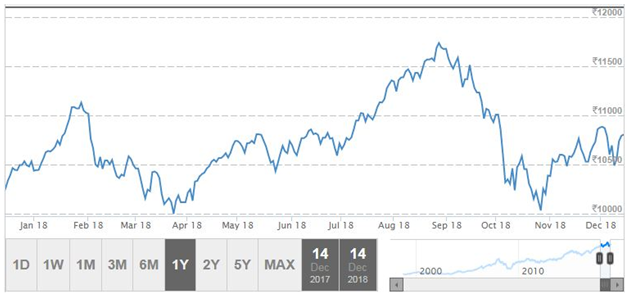How Mutual Fund Systematic Transfer Plan is a defence against volatility

High volatility in stock market poses dilemma for many investors. Investors with long investment horizons and high risk tolerance may want to invest irrespective of market levels. Some investors may wait for the market to correct more so that they can invest near market bottom. Investors who do not have high risk tolerance may wait for the correction to be over and for confirmation of uptrend trend before investing. Others may continue to invest through mutual fund systematic investment plans (SIPs). In this blog post, we will discuss a smart way of investing in volatile markets.
We have discussed a number of times in our blog that trying to time the market in a volatile is extremely difficult. In volatile markets, such as the one that we are experiencing over the last one year or so, it is very difficult to call which way the market will go in the near term. It is also difficult to guess price or market levels in the near term.
The Nifty lost 1,000 points in February and March this year; it then rallied more than 1,700 points from April to August. In September and October the Nifty lost 1,700 points and was back to March levels. In November it recovered 800 points, lost 300 points in the first week of December and has now recovered again at November levels. If you are waiting for market to bottom out, it is difficult to guess what the bottom is or will be.

Source: Moneycontrol.com
Systematic investing is the best way of investing in volatile markets. By investing a fixed amount every month or week or any other frequency, you can take advantage of volatility through Rupee Cost Averaging. When the market falls you can buy more units and over a period accumulate more units. When the market recovers, your gains will be higher and over your investment tenor, you will get superior returns. We usually associate systematic investing with mutual fund SIPs. However, you can take advantage of volatility even if you are investing in lump sum through a smart investing plan of mutual funds known as Systematic Transfer Plan (STP).
How does STP work?
STP or Systematic Transfer Plan essentially is a mechanism to transfer funds systematically from one mutual fund scheme to another. Let us assume you have lump sum money and want to invest in an equity mutual fund but you are worried that the market may fall or continue to fall for some time. You can invest your lump sum money in a liquid fund. Liquid fund is a low risk fund and your liquid fund investment will not be affected by stock market volatility. Using STP then you can transfer fixed amounts every month from liquid fund to the equity mutual fund of your choice; units of the liquid fund will be redeemed at the applicable NAVs on your chosen STP date and the redemption proceeds will be used to buy units of the equity mutual fund at applicable NAVs. STP is highly convenient because once you setup your STP the fund house will take care of the redemption and re-investments.
In many ways STP is similar to SIP because by investing a fixed amount of money every month in the equity fund, you will be able to take advantage of volatility. The main difference between STP and SIP is that, while in SIP the funds for systematic investment comes via auto debit from your savings bank account, in the case of the STP it comes from your investment in liquid fund.
Example of how STP will help you get higher returns in volatile market
Let us assume you wanted to invest Rs 1 Lakh on July 1, 2018 in the Nifty 50. Your market value of investment would be Rs 101,810 on December 13, 2018 (we have taken total returns). Let us examine a second case, where you invested your money lump sum in a liquid fund and set up instructions to transfer it to Nifty in 12 equal instalments from July 1, 2018 to July 1, 2019. Year to date average category return of liquid funds is 6.36%. We have assumed that equal monthly returns of 0.53% from the liquid fund so that the annual return is same as the category returns, Let us see the results of your STP on a month to month basis.

Source: Nifty values from National Stock Exchange
The above example is for illustration purpose only.
In July and August, when the market rallied you may have regretted setting up the STP. But in highly volatile markets gains made over 3 – 4 months can be wiped out in a few weeks or even days. About 50% of your investment as December 13 was still in liquid fund, which will provide stability to your investment if the market turns volatile again.
Will STP always give better returns than lump sum?
It depends on the period over which your STP is setup. If uptrend resumes in the middle of your STP tenor, then you will be buying units of equity funds at higher and higher costs and STP may not yield the desired results. However, one advantage of mutual fund STP is that you can ask the fund house to stop your STP at any time by sending a written Stop STP request. If you feel confident about the uptrend in the market, you can stop your STP and switch all the units of your liquid fund to the equity mutual fund (through switch request).
What should be the tenor of your STP?
One question we often get from investors regarding STP is about the right tenor of an STP. There is no right answer to this question. STP works best during volatile market conditions. It is always difficult to predict how long volatility will last. We have seen financial advisors recommend 3 to 6 month STP tenors. However, if there is a fairly deep correction in the market, say by 10% or more, then a longer STP tenor is more suitable. A deep correction is often due to macroeconomic factors, which takes time to resolve. However, past experience with bear markets over the last 20 years tells us that even the worst bear markets (e.g. 2008 financial crisis) usually do not last for more than a year.
Conclusion
Investors should understand that mutual fund STP works by redeeming a certain number of units (depending on the STP amount) of one scheme and reinvesting the redemption proceeds in another scheme. Redemptions can attract exit loads where applicable. That is why liquid funds, which have no exit loads, are ideal lump sum investment options for setting up your STP to an equity fund. Investors should also understand the tax consequences of the STP because short term capital gains tax often come into play in STPs. In conclusion, STP can help you take advantage of volatility even when you make lump sum investments. If you want to make lump sum investments but are worried about volatility at the same time, then you should ask your financial advisor about STP.
Disclaimer: The views expressed herein are based on internal data, publicly available information and other sources believed to be reliable. Any calculations made are approximations, meant as guidelines only, which you must confirm before relying on them. The information contained in this document is for general purposes only. The document is given in summary form and does not purport to be complete. The document does not have regard to specific investment objectives, financial situation and the particular needs of any specific person who may receive this document. The information / data herein alone are not sufficient and should not be used for the development or implementation of an investment strategy. The statements contained herein are based on our current views and involve known and unknown risk and uncertainties that could cause actual results, performance or event to differ materially from those expressed or implied in such statements. Past performance may or may not be sustained in the future. LIC Mutual Fund Asset Management Ltd. / LIC Mutual Fund is not guaranteeing / offering / communicating any indicative yield on investment made in the scheme(s). Neither LIC Mutual Fund Asset Management Ltd. and LIC Mutual Fund (the Fund) nor any person connected with them, accepts any liability arising from the use of this document. The recipients(s) before acting on any information herein should make his/her/their own investigation and seek appropriate professional advice and shall alone be fully responsible / liable for any decision taken on the basis of information contained herein.
Mutual Fund Investments are subject to market risk, read all scheme related documents carefully.
RECOMMENDED READS
LATEST ARTICLES
- LIC MF Money Market Fund: Good investment option for parking your idle funds
- LIC MF Small Cap Fund: A promising small cap fund for long term investors
- LIC MF Dividend Yield Fund: A suitable diversified equity in current market dynamics
- LIC MF Value Fund: A good fund for volatile markets
- LIC MF Focused Fund: Potential of creating alphas over long investment horizons
LIC Mutual Fund was established on 20th April 1989 by LIC of India. Being an associate company of India's premier and most trusted brand, LIC Mutual Fund is one of the well known players in the asset management sphere. With a systematic investment discipline coupled with a high standard of financial ethics and corporate governance, LIC Mutual Fund is emerging as a preferred Investment Manager amongst the investor fraternity.
Investor Centre
Follow LIC MF
More About LIC MF
POST A QUERY






